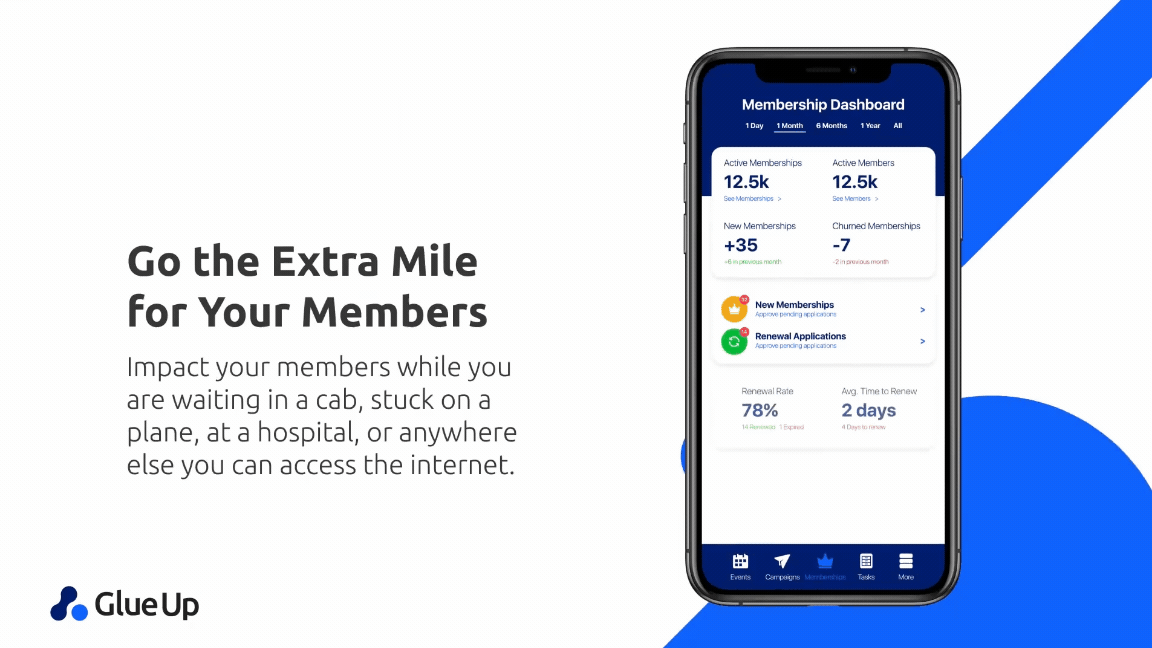
Any association or chamber thrives on strong member relationships. If the members are more connected with your association, it will be more successful. However, managing those relationships effectively requires a clear understanding of your members and their needs.
There can be no better alternative than membership tracking when it comes to learning membership needs. This comprehensive blog equips you with everything you need to know about membership tracking, from the basics to advanced strategies.
We'll explore the benefits, provide tips for maximizing the value you get from your member data, and provide a roadmap to successful membership tracking. So, whether you're just starting out or looking to refine your existing system, this guide will be your roadmap.
Key Takeaways
- Membership tracking helps associations understand member needs, personalize communication, and boost engagement through data management.
- Effective tracking enables member segmentation, re-engagement of inactive members, program effectiveness measurement, and personalized experiences.
- Integration with MMS, AI for data analysis, data visualization tools, and member journey mapping are transforming membership tracking practices.
- Clear goals, user-friendly tools, staff training, regular data analysis, and actionable insights are essential for effective membership tracking.
- Glue Up offers comprehensive features to enhance member tracking and engagement, such as member profiles, engagement metrics, communication tracking, event monitoring, automated campaigns, surveys, and analytics.
What is Membership Tracking?
Membership tracking is the systematic collection, storage, processing, and management of data related to your association or chamber's members. The data extracted from membership tracking forms the foundation for strong member relationships as it includes all the necessary insights like:
- Contact details (names, emails, phone numbers)
- Demographics (age, location, profession)
- Membership type and status (individual, corporate, active, expired)
- Interests and preferences
- Engagement history (event attendance, forum participation, resource usage)
In this way, you gain a clear understanding of your members and their interactions with the organization, and this data empowers you to:
- Personalize communication: Tailor messages and announcements to specific member segments based on their needs and interests.
- Boost engagement: Identify less engaged members and reach out with targeted efforts to revitalize their participation.
- Streamline operations: Automate routine tasks like membership renewals and event registrations for increased efficiency.
- Make data-driven decisions: Analyze member data to understand trends and preferences, allowing you to shape programs, events, and communication strategies that resonate best with your audience.
Membership tracking goes beyond core member details. Capturing a broader range of data points paints a richer picture of your members, allowing for more targeted strategies.
Here are some key areas to consider:
Membership Applications
Track application data, such as motivations for joining, areas of interest, objectives, and referral sources. This helps understand what attracts members and tailor future outreach accordingly.
Event Registrations
Analyze which events members register for and their attendance patterns. Use this data to identify popular topics and tailor future events to member preferences.
Website interactions
Track how members navigate your website, what resources they access, and what content they engage with. Overall, these insights will help you understand their needs and inform website updates.
Committee Participation
Monitor member involvement in committees and track their contributions. This allows you to recognize active members and identify potential leaders.
Capturing these diverse data points gives you a more concrete understanding of your member base. Moreover, it empowers you to personalize communication, enhance engagement, tailor your offerings, and ultimately build a stronger and more successful organization.
Why is Membership Tracking Important?
Membership tracking isn't just about keeping a record of your members; it's about unlocking a treasure of insights that can help you build a prosperous organization.
Here's how:
Segment Members
Track demographics, interests, and engagement patterns to segment your members into distinct groups. This allows you to tailor communication and offerings to their specific needs and preferences. For example, you would send targeted newsletters with relevant content instead of generic blasts.
In fact, businesses that tailor their offerings to customer segments generate 10% to 15% more revenue than those that don’t. The given statistics, however, emphasize the importance of member list segmentation, as it increases engagement and significantly boosts revenue.
Identify Disengaged Members
Member tracking helps you identify members who haven't been as active lately. Through member tracking, you can analyze members' past engagement and interests, identify the disengaged ones, and proactively reach out with targeted efforts to re-engage them.
This could involve personalized invitations to relevant events, special offers, or simply checking in to see if they require any assistance. Stats show that 52% of executives believe that lack of engagement is the primary reason members do not renew their membership, highlighting the importance of member tracking in identifying and re-engaging those disengaged members.
Measure Program Effectiveness
Tracking member participation in events, webinars, workshops, or online forums helps you gauge the effectiveness of your programs. Analyze which programs attract the most interest and identify areas for improvement. Anyway, this data-driven approach guarantees that you're offering valuable resources that resonate with your members.
Personalize Member Experiences
Imagine greeting your members by name, recommending resources based on their interests, and sending birthday wishes. Membership tracking makes personalization possible. Leveraging member information authorizes you to create a more enriching and individual experience for each member, promoting stronger loyalty and engagement.
According to reports, personalized emails deliver 6x higher transaction rates, highlighting the importance of member tracking in personalizing content, including emails and campaigns.
Conclusively, membership tracking entitles you to move beyond a one-size-fits-all approach. It equips you to cater to your members' unique needs, building deeper connections and building a more vibrant and successful organization.
Latest Trends in Membership Tracking: Optimizing Your Approach
The world of membership tracking is constantly evolving, offering exciting new tools and strategies.
Here's a glimpse into some of the hottest trends:
Integration with Membership Management Software (MMS)
Gone are the days of siloed data. Modern membership tracking leverages integration with dedicated MMS platforms. These platforms offer a centralized hub for storing, managing, and analyzing member data. Because MMS streamlines workflows automates tasks and provides valuable insights all in one place.
Leveraging Artificial Intelligence (AI)
AI is making its mark on membership tracking. AI-powered tools can analyze vast amounts of member data to identify trends, predict churn risk, and personalize communication. Imagine receiving automated suggestions for member re-engagement strategies or targeted content recommendations based on individual interests, which is the future of AI-powered tracking.
The Rise of Data Visualization
Data is powerful, but raw numbers can be overwhelming. Data visualization tools translate complex data sets into clear charts and graphs, making it easier to identify patterns and trends. Visualizations can reveal member demographics, engagement levels, and program effectiveness at a glance, empowering you to make data-driven decisions with greater clarity.
Focus on Member Journey Mapping
Membership tracking is shifting from a static snapshot to a dynamic journey. The focus is on mapping the member experience from initial contact to renewal and beyond. Tracking touchpoints throughout the journey can equip you to identify areas for improvement and guarantee your organization provides a seamless and engaging experience for every member.
These trends highlight the evolving landscape of membership tracking. However, embracing these advancements will unlock deeper member insights, optimize your engagement strategies, and build a stronger and more vibrant organization.
Use Cases in Association and Chamber of Commerce Space
Membership tracking empowers associations and chambers of commerce in distinct ways. Let's explore some specific use cases:
Chamber of Commerce
- Targeted Business Support: Track member business types and service offerings. This allows for targeted communication of relevant programs, workshops, or networking events aligned with their specific needs.
- Advocacy Efforts: Analyze member feedback and pain points to identify key advocacy issues. Use this data to build a stronger case for policy changes that benefit your members' businesses.
- Economic Development Initiatives: Track member job postings and hiring trends. This data can also be used to attract new businesses to the area and support workforce development initiatives.
Association
- Professional Development Opportunities: Track member skills and qualifications. Use this data to curate personalized learning recommendations and tailor professional development programs that address their specific needs.
- Certification and Credentialing: Track member progress in certification programs and renewal cycles. This ensures timely reminders and facilitates efficient process management.
- Community Building: Use member interests and location data to facilitate connections and foster a sense of community. Identify members with shared interests and encourage networking opportunities or regional events.
Associations and chambers of commerce can effectively implement these use cases to create a more personalized and valuable experience for their members. This ultimately leads to higher engagement, stronger loyalty, and a more thriving organization overall.
Frequently Asked Questions (FAQs) about Membership Tracking
What Are the Benefits of Membership Tracking?
A: Membership tracking offers a wealth of benefits, including:
- Personalized communication: Tailor messages and offerings to specific member segments.
- Boosted engagement: Identify disengaged members and re-engage them with targeted efforts.
- Streamlined operations: Automate tasks like renewals and registrations, saving time and resources.
- Data-driven decision-making: Gain insights to shape programs, events, and communication strategies.
What Data Should I Track for My Members?
A: Start with essential details like contact information, demographics, membership type and status, interests, and engagement history. You can also track data points like application details, event registrations, website interactions, and committee participation.
How Can I Get Started With Membership Tracking?
A: The simplest option is a spreadsheet, but it has limitations. Consider dedicated Membership Management Software (MMS) platforms for a more comprehensive and automated solution.
Is Membership Tracking Expensive?
Costs vary depending on the chosen method. Spreadsheets are free but limited. MMS platforms usually come with subscription fees, but they offer better value in the long run.
How Can I Measure the Success of My Membership Tracking Efforts?
Track key metrics like member engagement, event attendance, and renewal rates. Compare data before and after implementing membership tracking to assess its impact.
Expert Tips for Successful Membership Tracking
Membership tracking is a powerful tool, but like any tool, it's only as effective as the strategy behind it. Here are some expert tips to ensure your membership tracking efforts yield optimal results:
Set Clear Goals and Objectives
Don't just collect data for the sake of collecting data. Define your goals for membership tracking. Do you want to boost engagement, improve member retention, or personalize communication? Having clear objectives ensures your tracking efforts are laser-focused and aligned with your overall membership strategy.
Invest in User-Friendly Tracking Tools
Spreadsheets might work for a small group, but for most organizations, a dedicated Membership Management Software (MMS) is a wise investment. MMS platforms offer a user-friendly interface, robust data storage, automation capabilities, and valuable analytics tools. Choose a system that is easy for your staff to navigate and integrates seamlessly with your existing workflows.
Train Your Staff
Your staff is the backbone of successful membership tracking. Ensure they understand the importance of data accuracy and how to utilize the chosen tracking system effectively. Provide proper training to empower them to collect, manage, and analyze member data efficiently.
Communicate Results
Membership tracking isn't just about collecting data; it's about using it to inform decisions. Regularly analyze your data and share key insights with your team. Present findings in clear, concise reports that showcase the impact of your tracking efforts on member engagement, retention, or other relevant metrics.
Prioritize Action
Don't let valuable data sit idle. Use your findings to take action. Develop targeted communication campaigns based on member segmentation, tailor events to address member interests, or personalize outreach to re-engage inactive members.
Following these expert tips will help you transform membership tracking from a data collection exercise into a strategic advantage. It will empower you to build stronger relationships with your members, optimize your programs, and ultimately achieve your organizational goals.
Get Your Membership Tracking on Track with Glue Up

Effective membership tracking is the cornerstone of any thriving association or chamber. But managing spreadsheets and siloed data is a recipe for frustration. To truly understand your members and foster deeper connections, you need Membership Management Software (MMS) that's efficient, comprehensive, and delivers actionable insights.
That's where Glue Up steps in. It's not just another MMS. It's an all-in-one membership management solution designed to empower your organization. Glue Up goes beyond basic tracking, offering a robust suite of features to track all aspects of your members' experience:
Glue Up helps in member tracking through its comprehensive suite of features designed to monitor and analyze member behavior, engagement, and preferences. Here’s how:
- Member Profiles: Glue Up allows you to create detailed profiles for each member, capturing essential information such as demographics, interests, and engagement history. This centralized database helps you keep track of all member interactions and activities.
- Engagement Metrics: The platform provides detailed analytics on member engagement, including event attendance, participation in discussions, and interaction with content. This helps you identify active members and those who may need re-engagement.
- Communication Tracking: Glue Up tracks communication with members, such as email open rates, click-through rates, and response rates. This data helps you understand which messages resonate with your members and adjust your communication strategies accordingly.
- Event Participation: Monitor which members are attending your events, participating in webinars, or joining workshops. This data helps you gauge their interest levels and tailor future events to their preferences.
- Surveys and Feedback: Collect feedback from members through surveys and polls. Analyze this data to understand their needs and preferences better and adjust your offerings to meet their expectations.
- Reporting and Analytics: Generate reports on various member metrics to gain insights into engagement patterns and trends. Use these insights to make data-driven decisions and improve member satisfaction.
Utilizing these features, Glue Up helps associations effectively track member activities, understand their needs, and personalize interactions to enhance engagement and retention. To see how Glue Up can support your organization, book a demo today.



